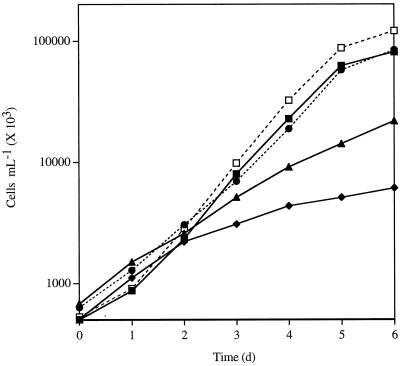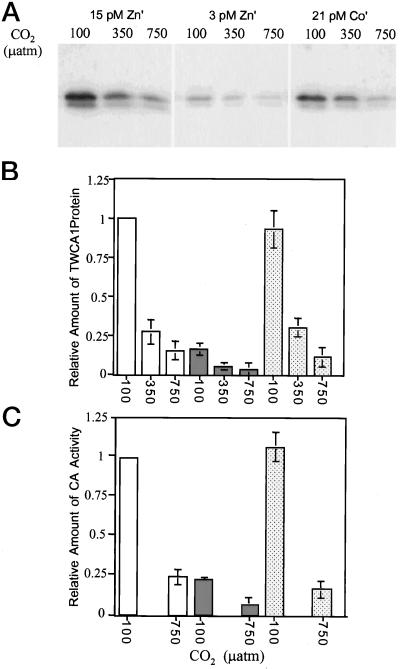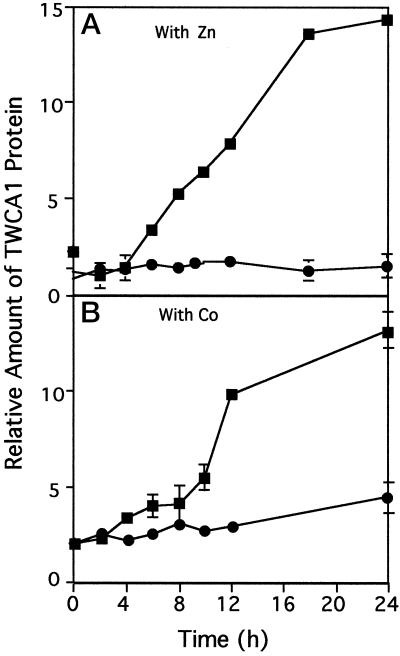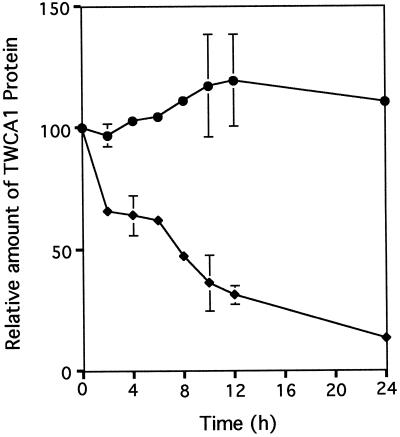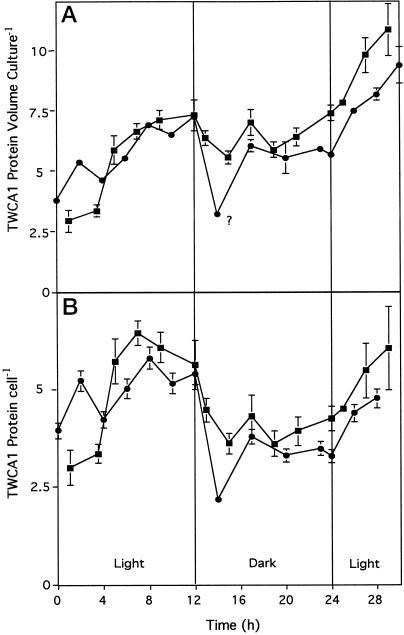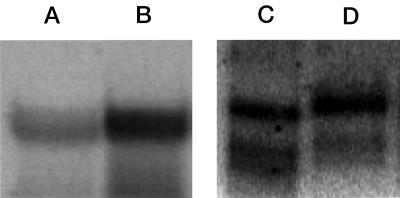Abstract
TWCA1 is the major Zn-requiring isoform of carbonic anhydrase (CA) in the marine diatom Thalassiosira weissflogii. We have examined the roles that trace metals and CO2 play in the regulation of TWCA1 expression over ranges of concentrations that bracket those encountered in the marine environment. Both steady-state levels of TWCA1 and the kinetics of induction were measured by western analysis. TWCA1 levels correlated well with cellular CA activity levels. TWCA1 was induced at a low CO2 concentration but the level of induction, as determined by western analysis, was dependent on the availability of Zn. Co effectively substituted for Zn in regulating TWCA1 expression and promoting TWCA1 activity. Upon shift from low to high CO2, the concentration of TWCA1 decreased. The expression of TWCA1 is diel cycle regulated, and cellular TWCA1 decreased during the dark phase. These results provide the basis for studying the expression of CA in field populations and, taken together with previous radiolabeling studies, provide strong evidence of in vivo metal substitution of Co for Zn in a CA. Our data also support the conclusion that TWCA1 plays a central role in carbon acquisition in T. weissflogii.
In marine environments, the predominant form of dissolved inorganic carbon is bicarbonate, whereas CO2 accounts for less than 1% of the total dissolved inorganic carbon (Millero, 1996). The carboxylating enzyme Rubisco, however, requires CO2 as a substrate (Cooper et al., 1969). To maintain efficient photosynthesis in spite of low CO2 availability, many phytoplankton species possess a carbon-concentrating mechanism (CCM) that functions both to increase the CO2 concentration in the vicinity of Rubisco (for review, see Badger et al., 1998; Kaplan and Reinhold, 1999) and to exploit the large pool of dissolved inorganic carbon that is in the form of HCO3−. The CCM is generally thought to have two key components: a mechanism for directly or indirectly taking up HCO3− and at least one carbonic anhydrase (CA), normally a Zn-requiring enzyme, that catalyzes the inter-conversion of HCO3− and CO2 (Badger and Price, 1994).
In marine diatoms (which are dominant primary producers in marine ecosystems), there is growing evidence from both the laboratory and the field of external HCO3− utilization, either by direct transport of the ion or by conversion of HCO3− to CO2 via an external CA. Recently, Nimer et al. (1997) demonstrated the direct uptake of HCO3− by the marine diatoms Phaeodactylum tricornutum and Thalassiosira pseudonana. Korb et al. (1997) demonstrated that at least three species of diatoms utilize external HCO3−, most likely by a direct uptake mechanism, although they were not able to completely rule out an external CA. Tortell et al. (1997) showed that natural assemblages of bloom-forming diatoms were able to take up HCO3− in an ethoxyzolamide (a CA inhibitor)-insensitive manner, and, furthermore, were able to generate internal inorganic carbon pools that were significantly more concentrated than the external medium.
The coastal diatom Thalassiosira weissflogii has been shown to have at least one CA, designated TWCA1. Its cDNA was recently cloned and sequenced (Roberts et al., 1997). The twca1 cDNA encodes a protein of 34 kD, which is processed by cleavage of the amino terminus to a truncated form with a predicted molecular mass of 26 kD. Antiserum raised against the cleaved form of TWCA1 recognized two bands on an SDS-PAGE gel of 27 and 26 kD (Roberts et al., 1997). The amino termini of both of these proteins had the same sequence, and it is possible that they may represent closely related isoforms, further processing, or partial degradation of the TWCA1 peptide.
The relationship of TWCA1 to other forms of CA is not completely clear. As twca1 is the only cDNA encoding a diatom CA that has been sequenced, information on the conservation of specific residues in the peptide sequence is not available. A direct comparison of the derived peptide sequence of TWCA1 to that of a large number other known CAs from a diversity of taxa indicates that the conserved residues defining the α-, β-, and γ-forms of CA are not found in the same relative positions in TWCA1 (Roberts et al., 1997). However, a protein database search (PROPSEARCH) based on protein properties (Hobohm and Sander, 1995) and using the full 34-kD derived peptide sequence of TWCA1 indicated that it may represent a distant homolog of α-CAs, CAH1 of Chlamydomonas reinhardtii being the most closely related protein. The same result is not obtained when we use the sequence of the 27-kD truncated form of TWCA1 that is found in vivo and known to be active (Roberts et al., 1997). A comparison of fragments of the TWCA1 sequence to that of CAH1 shows that the amino-terminal fragment of TWCA1 that is cleaved off in vivo contains a short stretch of amino acids that includes two His residues and resembles a portion of the active site of an α-CA. Because there is no evidence that this fragment re-associates with the larger fragment, final conclusions as to the relationship of these diatom CAs to other known forms should await sequence data from more than one example.
CAs are generally known to require Zn at the active site (Coleman, 1998), but evidence of in vivo utilization of Co and Cd in CA has been published (Price and Morel, 1990; Morel et al., 1994; Lee and Morel, 1995; Yee and Morel, 1996). CA constitutes a major use of Zn in at least some marine diatoms. At the concentrations of trace metals found in the surface waters of the open ocean, inorganic carbon utilization by T. weissflogii, a neritic species, has been shown to be impaired (Morel et al., 1994). For example, inorganic Zn concentrations (Zn′) in the surface waters of the central North Pacific are as low as 2 pm (Bruland, 1989). As a result, in some areas of the open ocean, sufficient trace metals may not be present for the efficient utilization of HCO3− by marine phytoplankton.
Because of the spectroscopic qualities of Co, the in vitro substitution of Co for Zn in α-CAs is well documented. The Co-containing form of the enzyme generally shows a marked decrease in activity compared with the native Zn form (Tu and Silverman, 1985). The demonstration that Zn can be extracted from a protein and replaced with Co in vitro is not evidence that such metal substitution can or does take place in vivo. The only evidence for in vivo metal substitution in a CA was provided by 65Zn and 57Co labeling studies in T. weissflogii (Morel et al., 1994; Yee and Morel, 1996), in which 65Zn and 57Co bands were found to co-migrate with a single band of CA activity on a native gel of diatom proteins.
Although the regulation of CA expression is well studied in the chlorophytic microalgae, there is a paucity of data for Bacillariophyceae and over the range of CO2 concentrations that are environmentally relevant. These studies are then of limited utility for marine systems. Furthermore, there is no information on the role of trace metals in the regulation of CA in microalgae, and only two studies of in vivo Zn/Co substitution. We examined the regulation of CA in the model marine diatom T. weissflogii over a range of CO2 and trace metal concentrations that are known to occur in the oceanic environment. In doing so, we provide further evidence that Co is substituting for Zn in CA in vivo. We also examined the regulation of TWCA1 protein levels by a diel cycle.
RESULTS
Zn/Co/CO2 Colimitation of Growth
Figure 1 illustrates the Zn/CO2 limitation of growth typical of T. weissflogii. At 3 pm Zn′, T. weissflogii showed a significant decrease in growth rate at 100 μatm CO2 compared with cultures grown at 15 pm Zn′. As previously observed (Morel et al., 1994), this deficit is partially relieved by growth at 750 μatm CO2, indicating that Zn limitation of growth is at least partly caused by an inadequate supply of inorganic carbon to the organism. The Zn/CO2 colimitation of growth was completely alleviated by the addition of 21 pm inorganic Co (Co′) to the culture, as essentially the same growth rate was observed as in Zn-sufficient cultures.
Figure 1.
Typical growth curves of T. weissflogii grown under different conditions of trace metals and CO2. ▪, 15 pm Zn′, 100 μatm CO2; ♦, 3 pm Zn′, 100 μatm CO2; ●, 21 pm Co′, 100 μatm CO2; ▴, 3 pm Zn′, 750 μatm CO2; □, 15 pm Zn′, 750 μatm CO2.
Modulation of TWCA1 Protein Levels by CO2, Zn, and Co
In order to characterize the regulation of TWCA1, we grew cultures of T. weissflogii under various concentrations of CO2, Zn′, and Co′, and then measured the relative amounts of TWCA1 by western analysis and phosphor imaging. As shown in Figure 2, A and B, the steady-state levels of TWCA1 in 100 μatm CO2-adapted, Zn-sufficient (15 pm Zn′) cultures were 10-fold higher than those seen in 750 μatm CO2-adapted cells under the same trace metal conditions. In Zn-limited cultures (3 pm Zn′), the steady-state levels of TWCA1 protein were markedly reduced compared with Zn-sufficient cells, about 10-fold at 100 μatm CO2. Adding Co to Zn-limited cultures restored essentially the same levels of TWCA1 protein as observed in the Zn-sufficient cultures.
Figure 2.
A, Typical phosphor image of western blot of whole-cell lysates of T. weissflogii grown under different conditions of CO2 and trace metals. B, Relative TWCA1 levels per cell determined by western analysis and phosphor imaging in cells grown under different concentrations of CO2 and trace metals. The graph represents the average of measurements from three independent sets of cultures. All measurements from the same blot were normalized to the value from the 100 μatm CO2, 15 pm Zn culture. C, Relative amounts of CA activity per cell in lysates of cells grown under different concentrations of CO2 and trace metals. The graph represents the average of three measurements from each of two independent sets of cultures. White bars, 15 pm Zn′; shaded bars, 3 pm Zn′; stippled bars, 21 pm Co′.
Modulation of CA Activity Levels
The relative amounts of CA activity, normalized per cell, were determined for lysates of cells grown under 100 and 750 μatm CO2 (Fig. 2C). The amount of CA activity resembled the TWCA1 protein levels measured by western analysis (compared in Fig. 2, B and C). The levels increased markedly at low pCO2, decreased under Zn limitation, and were restored by Co addition to Zn-limited cultures. The relative levels of activity did not vary in exact quantitative accord with the TWCA1 protein level, however. Western analysis may underrepresent the relative CA levels in high-CO2 cells. This may represent the inherent imprecision of each analysis or it may be due to the presence of other isoforms of CA not recognized by anti-TWCA1 serum.
Time Course of TWCA1 Induction or Degradation by CO2 Shift
The time required for high-CO2-adapted cells to respond to a rapid decrease in CO2 was determined in a series of CO2-shift experiments. At t = 0, the experimental culture was shifted to 100 μatm CO2 while the control remained at 750 μatm. The relative amount of TWCA1 present in the cells was determined at regular intervals for 24 h (Fig. 3A). A parallel series of experiments was carried out on cultures in which Zn had been replaced with Co (Fig. 3B). TWCA1 protein levels began to increase approximately 5 h after the CO2 shift, and steady-state levels of TWCA1 were attained approximately 18 h after the shift. The results from Zn- and Co-containing cultures did not differ significantly in terms of the time required for the initiation of induction (Fig. 3).
Figure 3.
A, Time course of TWCA1 induction by a shift in CO2 concentration in Zn-containing cultures. B, Time course of TWCA1 induction by shift in CO2 in Co-containing cultures. Cultures were preadapted to 750 μatm CO2. At t = 0, experimental cultures were shifted to 100 μatm CO2 and samples were withdrawn at the times indicated. Relative amounts of TWCA1 per cell were determined by western analysis and phosphor imaging. The graphs each represent the average of two separate experiments. When not shown, error bars are within the symbol. ▪, 100 μatm CO2; ●, 750 μatm CO2.
Adaptation to increased levels of CO2 was tested in a shift experiment in which Zn-sufficient cultures were preadapted to 100 μatm CO2 and then shifted to 750 μatm (Fig. 4). To compensate for dilution by cell division, protein from equal volumes of culture (rather than equal cell numbers) was loaded on the gel. Upon the shift to 750 μatm CO2, there was an immediate and rapid decline in the amount of TWCA1 present in the cells. A 10-fold decrease in the amount of TWCA1 protein was achieved in 24 h. This ratio between the levels of TWCA1 at the start and at the end of the experiment (Fig. 4) was the same as between cultures grown continuously at 100 versus 750 μatm CO2 (Fig. 2B).
Figure 4.
Time course of TWCA1 decrease in response to increased CO2 concentration. Cultures were preadapted to 100 μatm CO2. At t = 0, experimental cultures were shifted to 750 μatm CO2 and samples were withdrawn at the times indicated. Relative amounts of TWCA1 were determined by western analysis and phosphorimaging. All values were normalized to that of the initial timepoint (t = 0). The graph represents the average of two separate experiments. ●, 100 μatm CO2; ♦, 750 μatm CO2.
Time Course of TWCA1 Induction by Zn or Co Addition
Experiments to determine the time response to an increase in trace metal availability required large concentrations of slow-growing, Zn-limited cells at low CO2. Cultures were thus initially grown at 350 μatm CO2 to a density of 20,000 cells mL−1, then adapted to 100 μatm CO2 for at least 24 h prior to the start of the experiment. At t = 0, EDTA-buffered Zn or Co was added to a final concentration of 15 pm Zn′ or 21 pm Co′. Protein from an equal number of cells was loaded on the gel for each time point. Ten hours after the shift, a rapid increase in the amount of TWCA1 protein was observed, and steady-state levels of protein were present within 24 h (Fig. 5)—somewhat longer than the time required to respond to a CO2 shift. The responses to both metals were essentially identical.
Figure 5.
Time course of TWCA1 induction in response to addition of Zn (A) or Co (B). Cultures were preadapted to 100 μatm CO2 and 3 pm Zn′. At t = 0, experimental Zn-EDTA was added to a final Zn′ of 15 pm and samples were withdrawn at the times indicated. Relative amounts of TWCA1 were determined by western analysis and phosphor imaging. In A: ●, Zn added, and ▪, Zn limited; in B: ●, Co added, and ▪, Zn limited.
Diel Cycle Regulation
Cells were grown at 100 μatm CO2 on a 12-h light/dark cycle for six generations prior to the start of the experiments. Cell division was initiated during the last third of the light phase and continued for the first third of the dark phase. The amount of TWCA1 protein per unit culture volume steadily increased during the light phase until cell division was initiated (Fig. 6A). During the portion of the light phase in which cell division was occurring, the amount of TWCA1 protein per unit of culture volume remained constant and the amount of TWCA1 per cell decreased accordingly (Fig. 6B). The mean TWCA1 content per culture volume of the samples taken during the dark phase (excluding the low point marked with a “?”) was 15% lower than the final samples taken in the light phase (significant at the 95% confidence level). TWCA1 protein synthesis decreased or the rate of degradation increased early in the dark phase, and the levels of TWCA1 were stable for the remaining 8 h of the dark phase. This reduction in the amount of TWCA1 was much less dramatic than that brought about by an increase in CO2 (Fig. 4), with which the amount of TWCA1 protein decreased by 75% over a 12-h time interval.
Figure 6.
Time course of TWCA1 regulation by the diel cycle. Relative amounts of TWCA1 were determined by western analysis and phosphorimaging. A, Relative amounts of TWCA1 per unit culture volume B, Relative amounts of TWCA1 per cell. Each line represents data from an independent culture. ●, Experiment 1; ▪, experiment 2.
Northern Analysis
To determine if the regulation of induction of TWCA1 by CO2 availability is at the level of mRNA abundance, we examined by northern analysis the effect of a CO2 shift on the amount of twca1 transcript. Parallel Zn-sufficient cultures were grown at 750 μatm CO2. A t = 0, one culture was shifted to 100 μatm CO2 and incubation was continued for 3 h (Fig. 7). Comparing the relative amounts of radiolabel (as quantified by a phosphor imager) in uninduced (Fig. 7, lane A) versus induced cultures (Fig 7, lane B), the increase in twca1 mRNA levels in the culture shifted to low CO2 was approximately 5-fold. Replicate gel samples that were stained with ethidium bromide (Fig. 7, lanes C and D) clearly indicated that the amount of material loaded was roughly equivalent and could not account for the difference observed in mRNA levels.
Figure 7.
A and B, Phosphor image of a northern blot of total RNA probed with 32P-labeled antisense twca1 mRNA. Cultures were initially grown at 750 μatm CO2. At t = 0, the induced culture was shifted to 100 μatm CO2. After 3 h, cells were harvested. For both the uninduced (A) and induced (B) cultures, equal amounts of total RNA (30 μg) was loaded on the gel. There is a 5-fold increase in twca1 mRNA levels (as determined by phosphor imaging) in the 100 versus the 750 μatm CO2 sample. C and D, Negative image of ethidium bromide staining of duplicate samples loaded on the same gel. C, Uninduced; D, induced.
DISCUSSION
The range of CO2 concentrations used in this study is consistent with the roughly 100 to 700 μatm range reported for CO2 in coastal waters (Kemp and Pegler, 1991; Frankignoulle et al., 1996; Boehme et al., 1998). Over this range, there is not a significant change in total inorganic carbon in seawater, indicating that TWCA1 is indeed modulated by CO2 and not by total C. The Zn′ concentrations we used are based on values reported by Bruland (1989) for the North Pacific Ocean.
We previously reported (Roberts et al., 1997) that TWCA1 protein is induced by low CO2. We have now quantified this effect by western analysis and shown that the steady-state levels of TWCA1 protein are 10-fold greater in cultures grown at 100 than at 750 μatm CO2. This is approximately the same magnitude of induction as seen when Chlamydomonas reinhardtii is shifted from 50,000 to 350 μatm CO2 (Sültemeyer et al., 1990). In T. weissflogii, however, this difference is seen over a much narrower range of CO2 concentrations. Induction of an internal CA at low CO2 is consistent with active uptake of HCO3−.
The time required for T. weissflogii to adapt to decreased CO2 is significantly longer than that reported for chlorophytes. An increase in the amount of TWCA1 protein present in the cells was not detected before 5 h, and steady-state levels of the protein were achieved only after 18 h. In C. reinhardtii, induction kinetics have been characterized for CAH1, a periplasmic CA. The CAH1 polypeptide can be detected 2 h after induction (Yang et al., 1985; Dionisio-Sese et al., 1990), and steady-state levels of CA are reached 4 to 6 h after induction. Similar rapid kinetics of CA induction in response to a CO2 shift have been reported for Chlorella and Dunaliella spp. (Sültemeyer, 1997).
T. weissflogii responded rapidly to an increase in CO2. A significant decrease in TWCA1 protein was detected within 2 h of an increase in CO2, and a 75% reduction in TWCA1 levels was attained within 12 h. In C. reinhardtii, the periplasmic CAH1 enzyme remained stable after an increase in CO2, but the mitochondrial form of the enzyme, MCA1, was rapidly degraded under similar conditions (Eriksson et al., 1998). TWCA1 was isolated from the soluble fraction of cell lysates. It seems likely that at high CO2 concentrations, inappropriate internal CA activity would be more deleterious to the cell, and thus more likely to be targeted by regulated degradation than an external CA activity.
Co appears to function in essentially the same manner as Zn in TWCA1 regulation and activity. Co-containing cultures are virtually indistinguishable from Zn-sufficient cultures in both their production of TWCA1 protein and their growth rates. Co-containing cultures also displayed the same level of CA activity in cell lysates as those containing Zn. In contrast, when Co is substituted in vitro for Zn in α-CA, a significant decrease in activity is observed (Tu and Silverman, 1985). Our results are in agreement with previous results (Morel et al., 1994) showing that in 57Co-labeled cells, the radioactivity co-migrated with a band of CA activity in a native gel. This band of activity was shown by Roberts et al. (1997) to be TWCA1. Furthermore, Yee and Morel (1996), using a standard affinity chromatographic method for the purification of CAs, demonstrated that both CA activity and 57Co label co-purified. There was thus little doubt that a Co-CA could be found in T. weissflogii, and it seemed highly probable that this protein was indeed TWCA1. Our western analysis strongly affirms this conclusion, because antiserum raised against TWCA1 recognizes an identical set of bands on blots of total cellular protein from cultures grown with either Zn or Co. TWCA1 has little similarity to any of the previously described forms of CA (Roberts et al., 1997), and may represent a form of the enzyme that evolved around the ability to accept either Zn or Co at its active site. Western analysis of several diatom, chlorophyte, and haptophyte strains indicates that TWCA1 may represent a form of CA common in and limited to diatoms (T.W. Lane and F.M.M. Morel, unpublished data).
The responses of Zn/Co/CO2 co-limited cultures to Zn or Co addition were essentially identical to each other and significantly delayed compared with the response to a shift in CO2 concentration. Rapid increase in the amount of TWCA1 protein was not seen until 12 h after metal addition, whereas it was seen 5 h after a drop in CO2. The growth rate of the Zn-limited T. weissflogii cultures at low CO2 was about 5-fold lower than that of Zn-sufficient cultures. Therefore, the delay in TWCA1 increase in response to metal addition likely reflects the generally slower metabolism in metal-limited cells.
In T. weissflogii cultures grown on a light-dark cycle, there was an initial 15% decrease in the amount of TWCA1 during the dark phase, which was not due to dilution by cell division. This decrease is much lower than the 75% decrease observed 12 h after a shift from 100 to 750 μatm CO2, and brings up the question of the mechanism of regulation of TWCA1. If this regulation was normally affected in response to CO2 demand, one would expect complete degradation of TWCA1 during the dark phase. It may be that the major regulator of TWCA1 responds to internal CO2 concentration (or some closely related parameter), and that, during the dark phase, respiration results in elevated internal CO2 levels and a slight decrease in TWCA1 protein levels. The fate of the Zn associated with degraded CA is of interest because TWCA1 accounts for a large fraction of the intracellular Zn concentration in T. weissflogii, which is known to be regulated (Ahner and Morel, 1995). During the dark phase, the liberated Zn may be used by another metalloenzyme or it may be stored in some unknown peptide.
Largely due to the lack of a system for the genetic manipulation of diatoms, there is as yet no direct evidence for the role of TWCA1 in the CCM of diatoms. However, the data presented here provide strong circumstantial evidence for such a role. Zn limitation results in both low growth rates and low cellular levels of TWCA1. This limitation by Zn could be reversed by the addition of Co, a metal with few known functions in eukaryotes other than vitamin B12, and which we have shown can substitute for Zn in TWCA1. Thus, it is clear that the low growth rate observed under Zn limitation is at least partly the result of low cellular concentrations of TWCA1. Since the effect of Zn limitation can also be alleviated by increasing CO2, it would appear that the major function of TWCA1 is in the acquisition of carbon for photosynthesis. We note further that CA inhibitors have been shown to be effective in reducing very short-term (<10 s) carbon fixation in T. weissflogii (Tortell et al., 1997).
Northern analysis clearly demonstrates modulation of twca1 mRNA abundance by CO2, and this may indicate the level at which TWCA1 expression is regulated by CO2. The kinetics of TWCA1 accumulation upon induction by a decrease in CO2 is in good agreement with regulation at the level of transcript abundance rather than at the level of translation. Because the measurements of TWCA1 levels by western analysis do not distinguish between the apoenzyme and the holoenzyme, the variations in protein levels with varying Zn or Co concentrations and the kinetics of response to metal addition also argue that the regulation by trace metal availability is at the level of transcript abundance.
TWCA1, likely a central element of the CCM, represents a diatom-specific form of CA. It is the largest fraction of soluble Zn in T. weissflogii, and, as such, it constitutes a major use of the cell's potentially limited metal resources (Morel et al., 1994). The expression of TWCA1 appears to be tightly regulated over the range of CO2 and trace metal concentrations that the organism is likely to encounter in the natural environment. The ability of Co to substitute effectively for Zn at the active site of the enzyme is reflected in the regulation of its expression. Elucidating the regulation of CA activity in diatoms in response to environmental conditions should help us understand how these organisms acquire inorganic carbon and effect a major fraction of oceanic primary production.
MATERIALS AND METHODS
Culture Conditions
Thalassiosira weissflogii (clone Actin) cultures were grown at 20°C and 1 mmol photons m−2 s−1 in modified Aquil growth medium (Price et al., 1988/1989): 2.2 mm dissolved inorganic carbon and 300 μm NO3−, pH 8.2, with the Co and Zn levels as indicated in each individual experiment. Inorganic trace metal concentrations (M′) were calculated from total metal concentrations using the computer program MINEQL (Westall et al., 1976). Zn-Limited stock cultures were grown at 3 pm Zn′ for six generations prior to the inoculation of experimental cultures. Experimental cultures were grown under the appropriate conditions for five or more generations and harvested in the early exponential phase (approximately 25,000 cells mL−1). Gas mixtures were prepared in air with the designated concentrations of CO2. Cell concentrations were followed using a particle counter (Multisizer II, Coulter, Hialeah, FL).
CA Assays
CA assays were carried out by the method of Sületemeyer (1997) in 25 mm veronal buffer.
Western Analysis
SDS-PAGE and western analysis were carried out by standard methods (Sambrook et al., 1989) using high-titer polyclonal antiserum from rabbits directed against TWCA1 (Roberts et al., 1997) and [125I]protein A (NEN Life Sciences, Boston). Relative amounts of radioactivity were determined with a phosphor imager (Molecular Dynamics, Sunnyvale, CA). In time course experiments, phosphor imager values were normalized to the endpoint sample with the highest value: the final sample in induction experiments and the first sample in degradation experiments. Samples were harvested by filtration, pelleted by centrifugation, resuspended in SDS-PAGE sample buffer, and stored at −70°C.
Northern Analysis
Parallel cultures were grown with 15 pm Zn′ at 750 μatm CO2. When cell densities reached 50,000 cells mL−1, one culture was shifted to 100 μatm CO2. Incubation was continued for an additional 3 h, during which time cells were harvested by filtration, resuspended in TriReagent (Sigma, St. Louis), and stored at −70°C. Total cellular RNA was isolated by the method of Chomcyznski and Sacchi (1987) using TriReagent. RNA was electrophoresed in a formaldehyde-containing denaturing agarose gel (Sambrook et al., 1989) and transferred to a nylon membrane using a vacuum blotter (Stratagene, La Jolla, CA) and following the instructions of the manufacturer. The prehybridization, hybridization, and washing steps were carried out at 65°C using a reagent kit (Northern Max, Ambion, Austin, TX). The blot was probed with a single-stranded antisense RNA probe of the complete twca1 cDNA sequence labeled with 32P (NEN Life Sciences) using an in vitro transcription kit (MAXIscript, Ambion). The blot was washed at 65°C, and relative amounts of mRNA were determined by phosphor imaging.
ACKNOWLEDGMENTS
We thank Irene Schaperdoth for technical assistance and Jan Karlsson for bringing the protein property comparison of TWCA1 and α-CAs to our attention.
Footnotes
This work was supported by grants from the National Science Foundation and by the Center for Environmental Bioinorganic Chemistry.
LITERATURE CITED
- Ahner BA, Morel FMM. Phytochelatin production in marine algae: 2. Induction by various metals. Limnol Oceanogr. 1995;40:658–665. [Google Scholar]
- Badger MR, Andrews TJ, Whitney SM, Ludwig M, Yellowlees DC, Leggat W, Price GD. The diversity and coevolution of Rubisco, plastids, pyrenoids, and chloroplast-based CO2-concentrating mechanisms in algae. Can J Bot. 1998;76:1052–1071. [Google Scholar]
- Badger MR, Price GD. The role of carbonic anhydrase in photosynthesis. Annu Rev Plant Physiol Plant Mol Biol. 1994;45:369–392. [Google Scholar]
- Boehme SE, Sabine CL, Reimers CE. CO2 fluxes from a coastal transect: a time-series approach. Mar Chem. 1998;63:49–67. [Google Scholar]
- Bruland KW. Complexation of zinc by natural organic ligands in the central North Pacific. Limnol Oceanogr. 1989;34:269–285. [Google Scholar]
- Chomczynski P, Sacchi N. Single-step method of RNA isolation by acid guanidinium thiocyanate-phenol-chloroform extraction. Anal Biochem. 1987;162:156–159. doi: 10.1006/abio.1987.9999. [DOI] [PubMed] [Google Scholar]
- Coleman JE. Zinc enzymes. Curr Opin Chem Biol. 1998;2:222–234. doi: 10.1016/s1367-5931(98)80064-1. [DOI] [PubMed] [Google Scholar]
- Cooper TG, Filmer D, Wishnick M, Lane MD. The active species of “CO2” utilized by ribulose 1,5-diphosphate carboxylase. J Biol Chem. 1969;244:1081–1083. [PubMed] [Google Scholar]
- Dionisio-Sese ML, Fukuzawa H, Miyachi S. Light induced carbonic anhydrase expression in Chlamydomonas reinhardtii. Plant Physiol. 1990;94:1103–1110. doi: 10.1104/pp.94.3.1103. [DOI] [PMC free article] [PubMed] [Google Scholar]
- Eriksson M, Villand P, Gardestrom P, Samuelsson G. Induction and regulation of a low-CO2-induced mitochondrial carbonic anhydrase in Chlamydomonas reinhardtii. Plant Physiol. 1998;116:637–641. doi: 10.1104/pp.116.2.637. [DOI] [PMC free article] [PubMed] [Google Scholar]
- Frankignoulle M, Bourge I, Canon C, Dauby P. Distribution of surface seawater partial CO2 pressure in the English Channel and in the southern bight of the North Sea. Cont Shelf Res. 1996;16:381–395. [Google Scholar]
- Hobohm U, Sander C. A sequence property approach to searching protein databases. J Mol Biol. 1995;251:390–399. doi: 10.1006/jmbi.1995.0442. [DOI] [PubMed] [Google Scholar]
- Kaplan A, Reinhold L. CO2 concentrating mechanisms in photosynthetic microorganisms. Annu Rev Plant Phys Plant Mol Biol. 1999;50:539–570. doi: 10.1146/annurev.arplant.50.1.539. [DOI] [PubMed] [Google Scholar]
- Kemp S, Pegler K. Sinks and sources of CO2 in coastal seas: the North Sea. Tellus. 1991;43B:224–235. [Google Scholar]
- Korb RE, Saville PJ, Johnston AM, Raven JA. Sources of inorganic carbon for photosynthesis by three species of marine diatom. J Phycol. 1997;33:433–440. [Google Scholar]
- Lee JG, Morel FMM. Replacement of zinc by cadmium in marine phytoplankton. Mar Ecol Prog Ser. 1995;127:305–309. [Google Scholar]
- Millero FJ. Chemical Oceanography. Ed 2. Boca Raton, FL: CRC Press; 1996. [Google Scholar]
- Morel FMM, Reinfelder JR, Roberts SB, Chamberlain CP, Lee JG, Yee D. Zinc and carbon co-limitation of marine phytoplankton. Nature. 1994;369:740–742. [Google Scholar]
- Nimer NA, Iglesias-Rodriguez MD, Merrett MJ. Bicarbonate utilization by marine phytoplankton species. J Phycol. 1997;33:625–631. [Google Scholar]
- Price NM, Harrison GI, Hering J, Hudson RJ, Nirel PMV, Palenik B, Morel FMM. /1989) Preparation and chemistry of the artificial algal culture medium Aquil. Biol Oceanogr. 1988;6:443–461. [Google Scholar]
- Price NM, Morel FMM. Cadmium and cobalt substitution for zinc in a marine diatom. Nature. 1990;344:658–660. [Google Scholar]
- Roberts SB, Lane TW, Morel FMM. Carbonic anhydrase in the marine diatom Thalassiosira weissflogii (Bacillariophyceae) J Phycol. 1997;33:845–850. [Google Scholar]
- Sambrook J, Fritsch EF, Maniatis T. Molecular Cloning: A Laboratory Manual. Ed 2. Cold Spring Harbor, NY: Cold Spring Harbor Laboratory Press; 1989. [Google Scholar]
- Sültemeyer DF. Changes in the CO2 concentrating mechanism during the cell cycle in Dunaliella tertiolecta. Bot Acta. 1997;110:55–61. [Google Scholar]
- Sültemeyer DF, Fock HP, Canvin DT. Mass spectrometric measurement of intracellular carbonic anhydrase in high and low Ci cells of Chlamydomonas: studies using 18O exchange with 13C/18O-labeled bicarbonate. Plant Physiol. 1990;94:1250–1257. doi: 10.1104/pp.94.3.1250. [DOI] [PMC free article] [PubMed] [Google Scholar]
- Tortell PD, Reinfelder JR, Morel FMM. Active uptake of bicarbonate by diatoms. Nature. 1997;390:243–244. [Google Scholar]
- Tu CK, Silverman DN. Catalysis by cobalt(II)-substituted carbonic anhydrase II of the exchange of oxygen-18 between CO2 and H2O. Biochemistry. 1985;24:5881–5887. doi: 10.1021/bi00342a029. [DOI] [PubMed] [Google Scholar]
- Westall JC, Zachary JL, Morel FMM. MINEQL. R.M. Cambridge, MA: Parsons Laboratory, Massachusetts Institute of Technology; 1976. [Google Scholar]
- Yang S-Y, Tsuzuki M, Miyachi S. Carbonic anhydrase of Chlamydomonas reinhardtii: purification and studies on its induction using antiserum against Chlamydomonas carbonic anhydrase. Plant Cell Physiol. 1985;26:25–34. [Google Scholar]
- Yee D, Morel FMM. In vivo substitution of zinc by cobalt in carbonic anhydrase of a marine diatom. Limnol Oceanogr. 1996;41:573–577. [Google Scholar]



